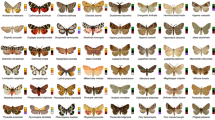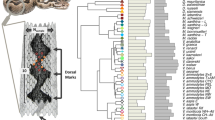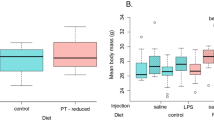Abstract
THE polymorphism exhibited by the two-spot ladybird, Adalia bipunctata Linn., in which specimens have a red ground colour and black spots (the typical morphs) or a black ground colour with red spots (the melanic morphs) is a well known phenomenon. The reasons for the existence of this polymorphism, however, are not well understood. Analogy to the situation in some melanic Lepidoptera, such as Biston betularia Linn.1,2, is unacceptable as it would seem that selective predation by birds upon the morphs which blend less well with their surroundings would not operate upon A. bipunctata. Ladybirds are distasteful, have a distinctive scent, are warningly coloured and therefore are avoided by vertebrate predators3,4.
This is a preview of subscription content, access via your institution
Access options
Subscribe to this journal
Receive 51 print issues and online access
$199.00 per year
only $3.90 per issue
Buy this article
- Purchase on Springer Link
- Instant access to full article PDF
Prices may be subject to local taxes which are calculated during checkout
Similar content being viewed by others
References
Kettlewoll, H. B. D., Heredity, Lond. 9, 323–42 (1955).
Kettlewell, H. B. D., Heredity, Lond. 10, 287–301 (1956).
Frazer, J. F. D., and Rothschild, M., Proc. 11th int. Cong. Ent. 3, 249–56 (1960).
Rothschild, M., Trans R. ent. Soc. Lond., 113, 101–21 (1961).
Creed, E. R., Heredity, Lond., 21, 57–72 (1966).
Ecological Genetics and Evolution, (edit. by Creed E. R.) (Blackwell, Oxford, 1971).
Creed, E. R., Evolution, Lancaster, Pa. 25, 290–93 (1971).
Hawkes, O. A. M., Entomologist'a mon. Mag., 63, 262–266 (1927).
Hawkes, O. A. M., Proc. zool. Soc. Lond. 1920, 475–490 (1920).
Kettlewell, H. B. D., The evolution of melanism (Clarendon Press, Oxford, 1973).
Lusis, J. J., Latv. Ent. 4, 3–29 (1961).
Digby, P. S. B., J. exp. Biol., 32, 279–98 (1955).
Dixon, A. F. G., J. anim. Ecol., 41, 689–97 (1972).
Benham, B. R., and Muggleton, J., Entomologist, 103, 153–70 (1970).
The Atlas of Britain and Northern Ireland, (edit. by Bickmore, D. P., and Shaw, M. A.), (Clarendon Press, Oxford, 1963).
Author information
Authors and Affiliations
Rights and permissions
About this article
Cite this article
BENHAM, B., LONSDALE, D. & MUGGLETON, J. Is polymorphism in two-spot ladybird an example of non-industrial melanism?. Nature 249, 179–180 (1974). https://doi.org/10.1038/249179a0
Received:
Revised:
Issue Date:
DOI: https://doi.org/10.1038/249179a0
This article is cited by
-
Melanism in a Chinese Population of Harmonia axyridis (Coleoptera: Coccinellidae): A Criterion for Male Investment with Pleiotropic Effects on Behavior and Fertility
Journal of Insect Behavior (2013)
-
Seasonal variation in elytral colour polymorphism in Harmonia axyridis (the ladybird beetle): the role of non-random mating
Heredity (1992)
-
The adaptive significance of alpine melanism in the butterfly Parnassius phoebus F. (Lepidoptera: Papilionidae)
Oecologia (1986)
-
The basis of thermal melanism in the ladybird Adalia bipunctata: Differences in reflectance and thermal properties between the morphs
Heredity (1985)
-
Colour, sunlight and internal temperatures in the land-snail Cepaea nemoralis (L.)
Oecologia (1975)
Comments
By submitting a comment you agree to abide by our Terms and Community Guidelines. If you find something abusive or that does not comply with our terms or guidelines please flag it as inappropriate.



